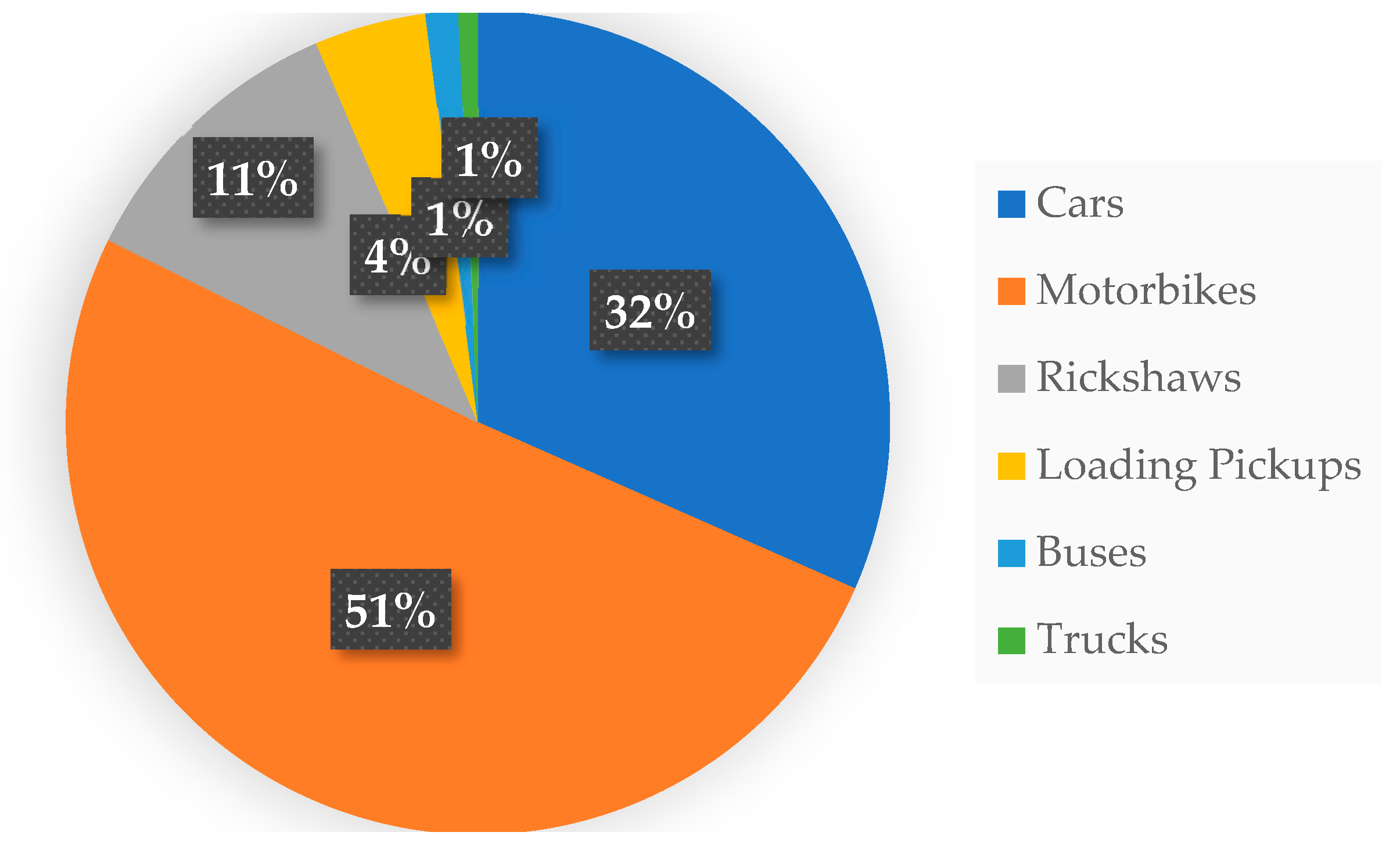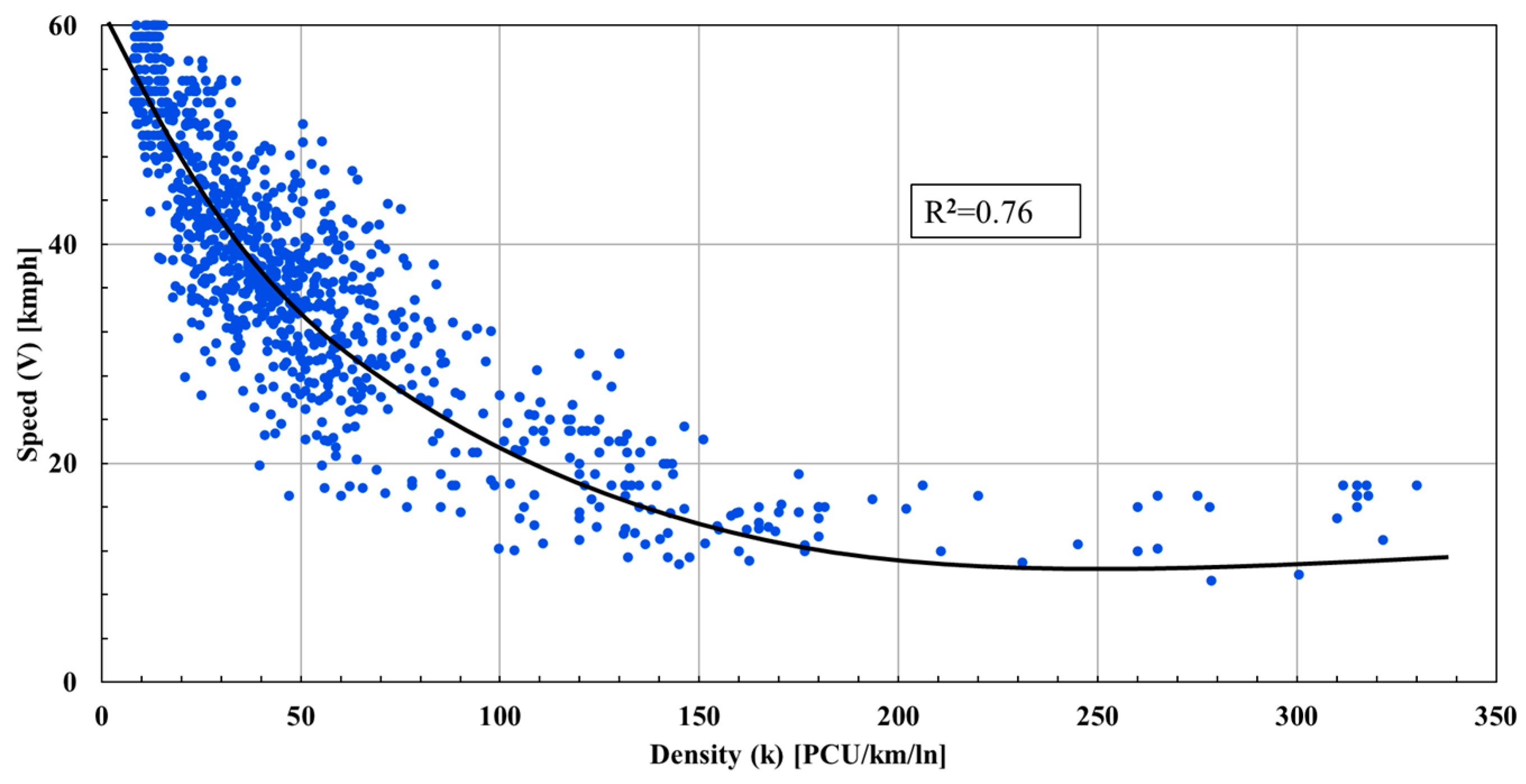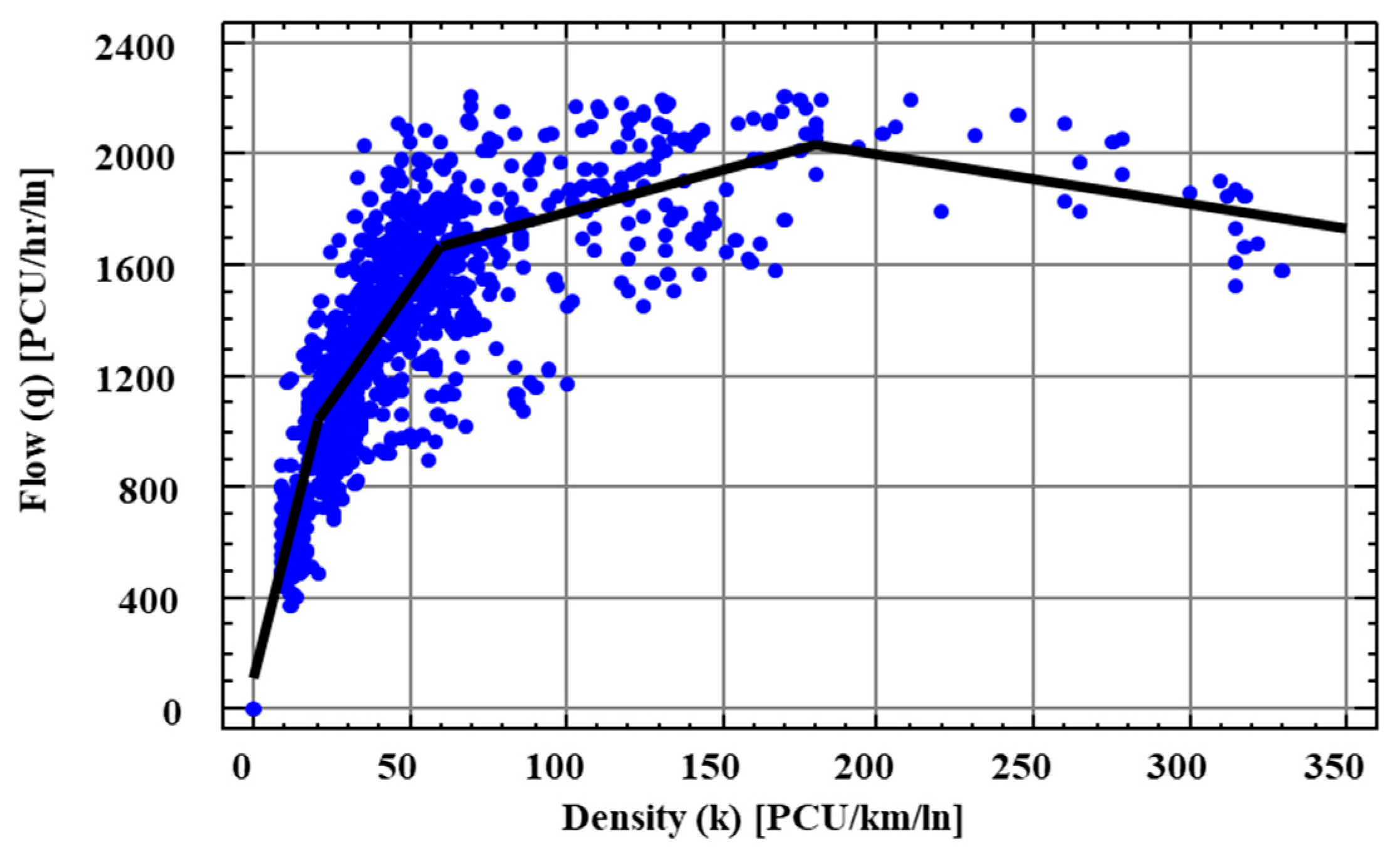Level of Service Criteria for Urban Arterials with Heterogeneous and Undisciplined Traffic Streams
Abstract
1. Introduction
1.1. Background
1.2. LOS Standards and Heterogeneous Traffic Realities
1.3. Objectives and Contributions
- Critical Evaluation and Gap Identification (diagnostic rigor): We systematically examine existing level of service (LOS) criteria for heterogeneous traffic, identifying critical deficiencies in current methodologies (e.g., overreliance on homogeneous traffic assumptions). Our analysis demonstrates that volume-to-capacity ratio threshold values are (more than 40%) higher for LOS A and B
- Data-Driven LOS Framework (methodological innovation): We propose novel, empirically grounded criteria using modeling and statistical techniques, validated through field-collected data. Our approach leverages fundamental diagrams to derive accurate free-flow speeds and capacity values, ensuring LOS categories reflect real-world heterogeneous traffic behavior. Our validation shows a 30% higher accuracy for capacity estimation in comparison to HCM’s lane-based metrics (Section 3.2)
- Cross-Standard Synthesis & Proposal (Practical synthesis): We evaluate the suitability of U.S. (HCM) and Indian (Indo-HCM) standards for undisciplined traffic streams and introduce a revised LOS criterion that correlates volume-to-capacity ratios with speed bands, offering actionable insights for infrastructure planning. Fundamental diagram-derived thresholds enable cities to calibrate LOS standards using local traffic data, avoiding costly HCM modifications.
2. Methodology
2.1. Data Collection and Extraction
2.2. Level of Service Criteria and Fundamental Diagrams
2.3. Alternative Clustering Algorithms for Determining LOS Threshold
3. Case Study and Results
3.1. Speed–Density Fundamental Diagram
- Parameter variations: coefficients remained stable (±5%) when excluding outliers or resampling data.
- Edge cases: the polynomial fit outperformed linear/exponential models (ΔR2 > 0.12) under extreme densities (e.g., >150 veh/km).
3.2. Flow–Density Fundamental Diagram
- Leave-one-out cross-validation (R2 stability: 0.71–0.76).
- Parameter sensitivity tests (e.g., ±10% density bin adjustments altered capacity estimates by <3%).
- Simulated extreme flows (e.g., 2500+ PCU/h/ln) confirmed the model’s piecewise logic over polynomial alternatives (ΔR2 > 0.08).
3.3. Clustering Analysis
- Achieved superior cluster separation (average silhouette width = 0.51).
- Maintained computational efficiency for our dataset.
- Showed the strongest alignment with HCM LOS classifications.
3.4. Comparison and Development of Level of Service Criteria
4. Discussion and Policy Implications
5. Conclusions and Recommendations
Author Contributions
Funding
Institutional Review Board Statement
Informed Consent Statement
Data Availability Statement
Conflicts of Interest
References
- Roess, R.P.; Vandehey, M.A.; Kittelson, W. Level of service: 2010 and beyond. Transp. Res. Rec. 2010, 2173, 20–27. [Google Scholar] [CrossRef]
- Navandar, Y.V.; Dhamaniya, A.; Patel, D. Empirical analysis of level of service based on users perception at manual tollbooth operation in India. Transp. Res. Procedia 2019, 37, 314–321. [Google Scholar] [CrossRef]
- Wang, M.; Mao, B.; Yang, Y.; Shi, R.; Huang, J. Determining the Level of Service Scale of Public Transport System considering the Distribution of Service Quality. J. Adv. Transp. 2022, 2022. [Google Scholar] [CrossRef]
- Yeramwar, C.; Kaley, A.; Bambode, K. Evaluation of capacity and level of service of roads. Int. J. Sci. Res. Sci. Eng. Technol. 2016, 2, 296–299. [Google Scholar]
- Manual, H.C. HCM2010; Transportation Research Board: Washington, DC, USA, 2010. [Google Scholar]
- Mathew, T.V.; Rao, K.K. Introduction to Transportation Engineering, NPTEL. Capacity and Level of Service. 2007. Available online: https://nptel.ac.in/courses/105101087 (accessed on 10 January 2025).
- Pandey, A.; Biswas, S. Assessment of Level of Service on urban roads: A revisit to past studies. Adv. Transp. Stud. 2022, 57. [Google Scholar]
- Roess, R.P. Level of service concepts: Development, philosophies, and implications. Transp. Res. Rec. 1984, 971, 1–6. [Google Scholar]
- Bhuyan, P.K.; Nayak, M.S. A review on level of service analysis of urban streets. Transp. Rev. 2013, 33, 219–238. [Google Scholar] [CrossRef]
- National Academies of Sciences, Engineering, and Medicine; Transportation Research Board. Highway Capacity Manual 7th Edition: A Guide for Multimodal Mobility Analysis; National Academies Press: New York, NY, USA, 2022. [Google Scholar]
- Kumar, P.G.; Samal, S.R.; Prasanthi, L.; Bhavitha, V.; Devi, J.M. Level of service of urban and rural roads-a case study in Bhimavaram. In IOP Conference Series: Materials Science and Engineering; IOP Publishing: Bristol, UK, 2020. [Google Scholar]
- Drew, D.R.; Keese, C.J. Freeway Level of Service as Influenced by Volume and Capacity Characteristics; Texas Transportation Institute: Bryan, TX, USA, 1965. [Google Scholar]
- Manual, H.C. Highway capacity manual. Transp. Res. Board 2000, 2, 5–7. [Google Scholar]
- McAndrews, C.; Pollack, K.M.; Berrigan, D.; Dannenberg, A.L.; Christopher, E.J. Understanding and improving arterial roads to support public health and transportation goals. Am. J. Public Health 2017, 107, 1278–1282. [Google Scholar] [CrossRef]
- Hu, X.; Qiao, L.; Hao, X.; Lin, C.; Liu, T. Research on the impact of entry points on urban arterial roads in the framework of Kerner’s three-phase traffic theory. Phys. A Stat. Mech. Appl. 2022, 605, 127962. [Google Scholar] [CrossRef]
- Deshpande, R.; Gartner, N.H.; Zarrillo, M.L. Urban street performance: Level of service and quality of progression analysis. Transp. Res. Rec. 2010, 2173, 57–63. [Google Scholar] [CrossRef]
- Tsela, D.; Duggal, E.A.K. Determination of Level of Service of Arterial Road in Kohima. Int. Res. J. Eng. Technol. 2021, 8, 1559–1564. [Google Scholar]
- Mohapatra, S.S. Level of Service Criteria of Urban Streets in Indian Context Using Advanced Classification Tools. Ph.D. Thesis, National Institute of Technology, Rourkela, India, 2012. [Google Scholar]
- Akbar, M.; Khan, R.; Khan, M.T.; Alam, B.; Elahi, M.; Wali, B.; Shah, A.A. Methodology for simulating heterogeneous traffic flow at intercity roads in developing countries: A case study of university road in Peshawar. Arab. J. Sci. Eng. 2018, 43, 2021–2036. [Google Scholar] [CrossRef]
- Srikanth, S.; Mehar, A. Development of MLR, ANN and ANFIS Models for estimation of PCUs at different levels of service. J. Soft Comput. Civ. Eng. 2018, 2, 18–35. [Google Scholar]
- Ahmed, A.; Ukkusuri, S.V.; Mirza, S.R.; Hassan, A. Width-based cell transmission model for heterogeneous and undisciplined traffic streams. Transp. Res. Rec. 2019, 2673, 682–692. [Google Scholar] [CrossRef]
- Ahmed, A.; Ali, M.S.; Ansari, T. Modelling Heterogeneous and Undisciplined Traffic Flow using Cell Transmission Model. Int. J. Traffic Transp. Manag. 2020, 2, 1–5. [Google Scholar] [CrossRef]
- Rao, A.M.; Rao, K.R. Measuring urban traffic congestion—A review. Int. J. Traffic Transp. Eng. 2012, 2, 286–305. [Google Scholar]
- Mallikarjuna, C.; Rao, K.R. Heterogeneous traffic flow modelling: A complete methodology. Transportmetrica 2011, 7, 321–345. [Google Scholar] [CrossRef]
- Patel, C.R.; Joshi, G. Capacity and LOS for urban arterial road in Indian mixed traffic condition. Procedia-Soc. Behav. Sci. 2012, 48, 527–534. [Google Scholar] [CrossRef]
- Akçelik, R. An assessment of the Highway Capacity Manual 2010 roundabout capacity model. In Proceedings of the TRB International Roundabout Conference, Carmel, IN, USA, 18–20 May 2011. [Google Scholar]
- Miller, A.J. On the Australian road capacity guide. Highw. Res. Rec. 1969, 289, 1–13. [Google Scholar]
- Othayoth, D.; Rao, K.K. Investigating the relation between Level of Service and volume-to-capacity ratio at signalized intersections under heterogeneous traffic condition. Transp. Res. Procedia 2020, 48, 2929–2944. [Google Scholar] [CrossRef]
- Marisamynathan, S.; Vedagiri, P. Pedestrian perception-based level-of-service model at signalized intersection crosswalks. J. Mod. Transp. 2019, 27, 266–281. [Google Scholar] [CrossRef]
- Chandra, S.; Gangopadhyay, S.; Velmurugan, S.; Ravinder, K. Indian Highway Capacity Manual (Indo-HCM); Council of Scientific and Industrial Research: New Delhi, India, 2017. [Google Scholar]
- Golakiya, H.D.; Dhamaniya, A. Evaluating LOS at urban midblock section under the influence of crossing pedestrians in mixed traffic conditions. Transp. Res. Procedia 2020, 48, 777–792. [Google Scholar] [CrossRef]
- Badveeti, A.; Mir, M.S.; Badweeti, K. The evaluation of traffic congestion analysis for the Srinagar City under mixed traffic conditions. In Recent Advances in Traffic Engineering; Springer: Berlin/Heidelberg, Germany, 2020; pp. 85–98. [Google Scholar]
- Manzoor, M.F.; Dar, M.N. Study on capacity and level of service for urban areas under mixed traffic conditions: A case study of srinagar city. Int. Res. J. Eng. Technol. 2020, 7, 3103–3115. [Google Scholar]
- Patnaik, A.K. Level of Service Criteria of Roads in Urban Indian Context. Ph.D. Thesis, National Institute of Technology, Rourkela, India, 2013. [Google Scholar]
- Maitra, B.; Sikdar, P.; Dhingra, S. Modeling congestion on urban roads and assessing level of service. Int. J. Transp. Eng. 1999, 125, 508–514. [Google Scholar] [CrossRef]
- Marwah, B.; Singh, B. Level of service classification for urban heterogeneous traffic: A case study of Kanpur metropolis. In Proceedings of the Fourth International Symposium on Highway Capacity, Maui, HI, USA, 27 June–1 July 2000. [Google Scholar]
- Rahimi, M.R.; Vala, M.; Patel, B.N. Evaluation of Capacity and Level of Service for Selected Urban Arterial Roads—A Case Study of Rajkot City; Springer: Singapore, 2020. [Google Scholar]
- Yi, P.; Lu, J.; Zhang, Y.; Lu, H. Safety-based capacity analysis for Chinese highways: A preliminary study. IATSS Res. 2004, 28, 47–55. [Google Scholar] [CrossRef]
- Zhou, R.; Zhong, L.; Zhao, N.; Fang, J.; Chai, H.; Zhou, J.; Li, W.; Li, B. The development and practice of China highway capacity research. Transp. Res. Procedia 2016, 15, 14–25. [Google Scholar] [CrossRef]
- Indonesian Highway Capacity Manual Part I-Urban Roads; Highways, D.G.O., Ed.; Directorate General of Highways: Jakarta, Indonesia, 1993.
- Wu, N. New Features in the 2015 German Highway Capacity Manual (HBS2015). Transp. Res. Procedia 2017, 1–16. [Google Scholar]
- Ahmed, A.; Ngoduy, D.; Adnan, M.; Baig, M.A.U. On the fundamental diagram and driving behavior modeling of heterogeneous traffic flow using UAV-based data. Transp. Res. Part A Policy Pract. 2021, 148, 100–115. [Google Scholar] [CrossRef]
- Ahmed, A.; Noman, S.M.; Baig, M.A.U.; Ngoduy, D.; Adnan, M.; Ismail, M.A.; Qadir, A. Estimating passenger car equivalent factors for heterogeneous traffic using occupancy-density linear regression model. Transp. Res. Rec. 2022, 2676, 209–220. [Google Scholar] [CrossRef]
- Hastie, T.; Tibshirani, R.; Friedman, J. The Elements of Statistical Learning: Data Mining, Inference, and Prediction; Springer: Berlin/Heidelberg, Germany, 2009; Volume 2. [Google Scholar]
- Xia, J.; Chen, M. Defining traffic flow phases using intelligent transportation systems-generated data. J. Intell. Transp. Syst. 2007, 11, 15–24. [Google Scholar] [CrossRef]
- Sun, L.; Zhou, J. Development of multiregime speed–density relationships by cluster analysis. Transp. Res. Rec. 2005, 1934, 64–71. [Google Scholar] [CrossRef]
- Oh, C.; Tok, A.; Ritchie, S.G. Real-time freeway level of service using inductive-signature-based vehicle reidentification system. IEEE Trans. Intell. Transp. Syst. 2005, 6, 138–146. [Google Scholar] [CrossRef]
- Azimi, M.; Zhang, Y. Categorizing freeway flow conditions by using clustering methods. Transp. Res. Rec. 2010, 2173, 105–114. [Google Scholar] [CrossRef]
- Greenshields, B.; Channing, W.; Miller, H. A study of traffic capacity. In Proceedings of the Annual Meeting of the Highway Research Board, Washington, DC, USA, 6–7 December 1934; National Research Council: Washington, DC, USA, 1935; Volume 14, pp. 448–477. [Google Scholar]
- Greenberg, H. An analysis of traffic flow. Oper. Res. 1959, 7, 79–85. [Google Scholar] [CrossRef]
- Drake, J.S. A statistical analysis of speed density hypothesis. HRR 1967, 154, 53–87. [Google Scholar]
- Joshi, G.; Sinha, V.; Patel, J. Heterogeneous traffic characterisation and flow behaviour modeling for metropolitan arterial in India. J. East. Asia Soc. Transp. Stud. 2011, 9, 1684–1699. [Google Scholar]
- Kurniati, T.; Purnawan, P.; Yosritzal, Y.; Putri, E.E.; Alfaroji, A. The study of speed-volume-density relationships with various motorcycles volume percentages. In AIP Conference Proceedings; AIP Publishing: Melville, NY, USA, 2024; Volume 2891. [Google Scholar]
- Saha, A.; Chandra, S.; Ghosh, I. Assessment of level of service for urban signalized intersections in India. Curr. Sci. 2019, 117, 1516–1521. [Google Scholar] [CrossRef]
- Minh, C.C.; Sano, K.; Matsumoto, S. The speed, flow and headway analyses of motorcycle traffic. J. East. Asia Soc. Transp. Stud. 2005, 6, 1496–1508. [Google Scholar]
- Das, A.K.; Bhuyan, P.K. Hardcl method for defining LOS criteria of urban streets. Int. J. Civ. Eng. 2017, 15, 1077–1086. [Google Scholar] [CrossRef]
- Bhat, C.R. A heteroscedastic extreme value model of intercity travel mode choice. Transp. Res. Part B Methodol. 1995, 29, 471–483. [Google Scholar] [CrossRef]
- Patnaik, A.K.; Bhuyan, P.K.; Rao, K.K. Divisive Analysis (DIANA) of hierarchical clustering and GPS data for level of service criteria of urban streets. Alex. Eng. J. 2016, 55, 407–418. [Google Scholar] [CrossRef]
- Vivek, A.K.; Mohapatra, S.S.; Jena, S. Evaluation of user perception to define level of service criteria of rail road grade crossing: An exploratory statistical approach. Transp. Policy 2022, 122, 64–76. [Google Scholar] [CrossRef]
- Choocharukul, K.; Sinha, K.C.; Mannering, F.L. User perceptions and engineering definitions of highway level of service: An exploratory statistical comparison. Transp. Res. Part A Policy Pract. 2004, 38, 677–689. [Google Scholar] [CrossRef]
- Arellana, J.; Fuentes, L.; Cantillo, J.; Alvarez, V. Multivariate analysis of user perceptions about the serviceability of urban roads: Case of Barranquilla. Int. J. Pavement Eng. 2021, 22, 54–63. [Google Scholar] [CrossRef]
- Rodriguez-Valencia, A.; Unda, R.; Paris, D.; Barrero, G.A.; Bocarejo, J.P. Comparing perception-based methods and traditional level of service for urban infrastructure evaluation: Bogotá’s road diet case study. Case Stud. Transp. Policy 2025, 19, 101354. [Google Scholar] [CrossRef]
- Othayoth, D.; Rao, K.K.; Bhavathrathan, B. Perceived level of service at signalized intersections under heterogeneous traffic conditions. Transp. A Transp. Sci. 2020, 16, 1294–1309. [Google Scholar] [CrossRef]
- Macioszek, E.; Tumminello, M.L. Simulating vehicle-to-vehicle communication at roundabouts. Transp. Probl. Int. Sci. J. 2024, 19, 45–57. [Google Scholar] [CrossRef]





| Level of Service | Indian HCM | US-HCM | |
|---|---|---|---|
| Volume/Capacity Ratio | Travel Speed as Percentage of Free Flow Speed | ||
| LOS A | <0.15 | >84 | >80 |
| LOS B | 0.15–0.45 | 83–76 | >67–80 |
| LOS C | 0.46–0.75 | 75–59 | >50–67 |
| LOS D | 0.76–0.85 | 58–41 | >40–50 |
| LOS E | 0.86–1.00 | 40–22 | >30–40 |
| LOS F | >1.00 | <22 | ≤30 |
| Time Interval | Volume (PCU/h) |
|---|---|
| 7:00–8:00 | 2834 |
| 8:00–9:00 | 3233 |
| 17:00–18:00 | 5447 |
| 18:00–19:00 | 5698 |
| Model | Free-Flow Speed (km/h) | Jam-Density (PCU/km/ln) | RMSE (km/h) | R2 | |
|---|---|---|---|---|---|
| Greenshields [49] | 64 | 300 | 4.9 | 0.68 | |
| Greenberg [50] | - | 340 | 5.0 | 0.66 | |
| Drake [51] | 57 | - | 5.3 | 0.72 | |
| Second-order | 60 | - | 4.7 | 0.76 |
| Clusters Number | Clusters | Speed Ranges (kmph) | Mean-Square for Clusters | df | Significance Value |
|---|---|---|---|---|---|
| 1 | 58.67 | 60–52 | 27,016.089 | 5 | 0.000 |
| 2 | 51.89 | 52–44 | |||
| 3 | 44.19 | 44–37 | |||
| 4 | 37.1 | 37–29 | |||
| 5 | 29.11 | 29–17 | |||
| 6 | 17.67 | 17 |
| Level of Service | Travel Speed as a Percentage of Base Free Flow Speed | V/C (Indian HCM) | V/C (Karachi) | |
|---|---|---|---|---|
| US HCM-2022 | Indian HCM | |||
| LOS A | >80 | >84 | <0.15 | <0.45 |
| LOS B | >67–80 | >76–84 | 0.15–0.45 | 0.45–0.63 |
| LOS C | >50–67 | >59–76 | 0.46–0.75 | 0.63–0.73 |
| LOS D | >40–50 | >41–59 | 0.76–0.85 | 0.73–0.83 |
| LOS E | >30–40 | >22–41 | 0.86–1.00 | 0.83–0.96 |
| LOS F | ≤30 | ≤22 | >1.00 | >0.96 |
| Level of Service | Travel Speed as Percentage of Base Free Flow Speed | Volume to Capacity Ratios | |||
|---|---|---|---|---|---|
| HCM-2022 | Indian HCM | This Research (University Road, Karachi) | Indian HCM | This Research (University Road, Karachi) | |
| LOS A | >80 | > 84 | >87 | <0.15 | <0.41 |
| LOS B | >67–80 | >76–84 | >73–87 | 0.15–0.45 | 0.41–0.66 |
| LOS C | >50–67 | >59–76 | >62–73 | 0.46–0.75 | 0.66–0.72 |
| LOS D | >40–50 | >41–59 | >48–62 | 0.76–0.85 | 0.72–0.80 |
| LOS E | >30–40 | >22–41 | >28–48 | 0.86–1.00 | 0.80–0.92 |
| LOS F | ≤30 | ≤22 | ≤28 | >1.00 | >0.92 |
Disclaimer/Publisher’s Note: The statements, opinions and data contained in all publications are solely those of the individual author(s) and contributor(s) and not of MDPI and/or the editor(s). MDPI and/or the editor(s) disclaim responsibility for any injury to people or property resulting from any ideas, methods, instructions or products referred to in the content. |
© 2025 by the authors. Licensee MDPI, Basel, Switzerland. This article is an open access article distributed under the terms and conditions of the Creative Commons Attribution (CC BY) license (https://creativecommons.org/licenses/by/4.0/).
Share and Cite
Ahmed, A.; Khan, F.; Rizvi, S.F.A.; Outay, F.; Ahmed, M.F.; Adnan, M. Level of Service Criteria for Urban Arterials with Heterogeneous and Undisciplined Traffic Streams. Sustainability 2025, 17, 5126. https://doi.org/10.3390/su17115126
Ahmed A, Khan F, Rizvi SFA, Outay F, Ahmed MF, Adnan M. Level of Service Criteria for Urban Arterials with Heterogeneous and Undisciplined Traffic Streams. Sustainability. 2025; 17(11):5126. https://doi.org/10.3390/su17115126
Chicago/Turabian StyleAhmed, Afzal, Farah Khan, Syed Faraz Abbas Rizvi, Fatma Outay, Muhammad Faiq Ahmed, and Muhammad Adnan. 2025. "Level of Service Criteria for Urban Arterials with Heterogeneous and Undisciplined Traffic Streams" Sustainability 17, no. 11: 5126. https://doi.org/10.3390/su17115126
APA StyleAhmed, A., Khan, F., Rizvi, S. F. A., Outay, F., Ahmed, M. F., & Adnan, M. (2025). Level of Service Criteria for Urban Arterials with Heterogeneous and Undisciplined Traffic Streams. Sustainability, 17(11), 5126. https://doi.org/10.3390/su17115126






